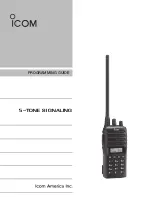
CIRCUIT DESCRIPTION
WJ-8711A DIGITAL HF RECEIVER
6-4
The reference generator uses a phase-locked-loop synthesizer to control a temperature
compensated, voltage controlled crystal oscillator, producing a highly stable 10 MHz reference signal that is
used as the time base for the receiver. In the standard receiver, using the Type 797006-1 or 797006-3 RF
Assembly, the stability of the reference is .7 ppm. Where greater stability is required, the optional Type
797006-2 and 797006-4 assemblies provide 0.2 PPM stability. Additionally, the reference generator may be
locked to an external reference by connecting an external 1, 2, 5, or 10 MHz reference signal, at a level of
200 mV rms, at the rear panel EXT REF connector (A3J3). When an external input at one of the specified
frequencies is present at this input, its presence is automatically sensed, and the internal 10 MHz reference
generator phase-locks to the external signal. The phase-locked internal 10 MHz reference is then provided as
the time base for the 1st, 2nd, and 3rd local oscillators.
The 1st LO circuit is a translation oscillator, comprised of the 1st LO VCO, a coarse tuning
phase-locked-loop synthesizer, and a fine tuning phase-locked-loop synthesizer. The combined circuitry
produces the variable 1st LO output, used to provide signal tuning. The output ranges from 40.455 MHz to
70.455 MHz for tuned frequencies ranging from 0.0000 to 30.0000 MHz, respectively. This output is
provided to the first mixer (U28) to produce a 40.455 MHz 1st IF.
The 2nd LO circuit produces a fixed 40 MHz output. It is produced by multiplying the 10
MHz reference signal by a factor of four. The 40 MHz output is then provided to the 2nd mixing stage (U30)
to produce 455 kHz 2nd IF. The 40 MHz 2nd LO is also provided to the Digital Assembly for use as the time-
base for the control microprocessor and analog to digital conversion circuitry. This signal is output via pin 23
of connector A3E1 (LO2).
The 3rd LO circuit uses a phase-locked-loop synthesizer, locked to the 10 MHz reference, to
produce the fixed 430 kHz 3rd LO signal. This 430 kHz signal is provided to the 3rd mixing stage (U31) to
produce the 25 kHz 3rd IF. The 430 kHz 3rd LO signal is also directed via pin 17 of A3E1 to the Digital
Assembly. It is used in the Digital Assembly for analog reconstruction of the IF signal for output to the rear
panel IF OUT (A2J1).
The RF/IF signal path accepts the 0 to 30.0000 MHz input spectrum, provides input filtering,
and using multiple conversion stages, produces the 455 kHz and 25 kHz IF outputs. The signal enters the
assembly via the 50 ohm RF IN rear panel connector (A3J1). The signal passes through a lowpass input
roofing filter, having a nominal 32 MHz cutoff frequency. This permits the 0.5000 to 30.0000 MHz HF
spectrum to pass while attenuating signals above the receiver tuning range. The input filtering provides
improved IF and image frequency rejection. Beyond the 32 MHz cutoff frequency, the filter response drops
sharply, providing approximately 80 dB of ultimate attenuation. The filtered RF input is then directed through
a selectable front end gain/attenuation control circuit, providing three operator selectable front end settings. It
permits the operator to route the signal directly to the 1st conversion stage, or, depending on signal conditions,
introduce front end gain or attenuation. In the NORMAL mode, the signal is passed directly through this
circuit with no effect on signal amplitude. Under weak signal conditions, the +10 dB gain path provides 10 dB
of signal amplification. The third signal path is for extremely strong signal conditions. The -15 dB selection
passes the signal through a 15 dB resistive pad to reduce the signal entering the receiver front end. This
attenuation pad is capable of dissipating up to 1 watt to provide protection at the receiver input.
Courtesy of http://BlackRadios.terryo.org
Summary of Contents for WJ-8711A
Page 4: ...iv THIS PAGE INTENTIONALLY LEFT BLANK Courtesy of http BlackRadios terryo org...
Page 19: ...1 i SECTION I GENERAL DESCRIPTION Courtesy of http BlackRadios terryo org...
Page 33: ...2 i SECTION II INSTALLATION Courtesy of http BlackRadios terryo org...
Page 34: ...2 ii THIS PAGE INTENTIONALLY LEFT BLANK Courtesy of http BlackRadios terryo org...
Page 47: ...3 i SECTION III LOCAL OPERATION Courtesy of http BlackRadios terryo org...
Page 48: ...3 ii THIS PAGE INTENTIONALLY LEFT BLANK Courtesy of http BlackRadios terryo org...
Page 93: ...4 i SECTION IV RS 232 REMOTE OPERATION Courtesy of http BlackRadios terryo org...
Page 94: ...4 ii THIS PAGE INTENTIONALLY LEFT BLANK Courtesy of http BlackRadios terryo org...
Page 123: ...5 i SECTION V CSMA REMOTE CONTROL Courtesy of http BlackRadios terryo org...
Page 124: ...5 ii THIS PAGE INTENTIONALLY LEFT BLANK Courtesy of http BlackRadios terryo org...
Page 143: ...6 i SECTION VI CIRCUIT DESCRIPTION Courtesy of http BlackRadios terryo org...
Page 157: ...7 i SECTION VII MAINTENANCE Courtesy of http BlackRadios terryo org...
Page 158: ...7 ii THIS PAGE INTENTIONALLY LEFT BLANK Courtesy of http BlackRadios terryo org...
Page 189: ...8 i SECTION VIII REPLACEMENT PARTS LIST Courtesy of http BlackRadios terryo org...
Page 190: ...8 ii THIS PAGE INTENTIONALLY LEFT BLANK Courtesy of http BlackRadios terryo org...
Page 241: ...FP i FOLDOUTS Courtesy of http BlackRadios terryo org...
Page 242: ...FP ii THIS PAGE INTENTIONALLY LEFT BLANK Courtesy of http BlackRadios terryo org...
















































